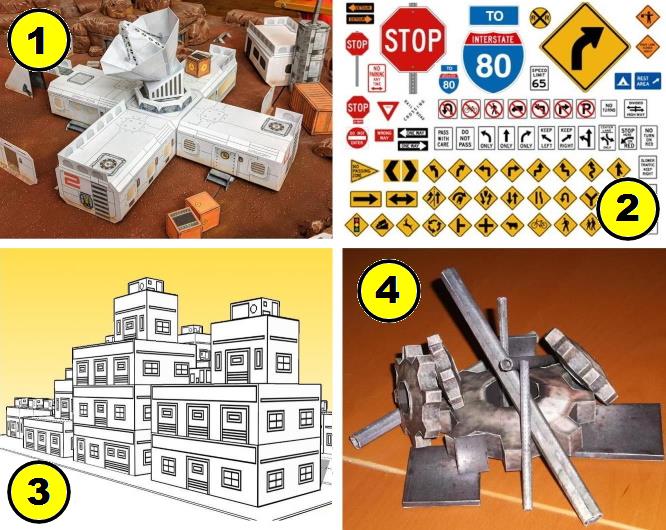At last, the papercraft of the *Globe Slicers* façade is ready for download.
The complete model takes up four sheets and, when printed on A4 or Letter paper, comes out at an approximate scale of 1/35.
The car shown in some of the photos is a miniature of a 1971 Chevrolet Opala SS, a Brazilian classic that combined the body of the European Opel Rekord with the style and power of the American Chevrolet Impala - which is where the name “Opala” came from.
This Opala miniature is in 1/43 scale, but with the right camera angle I think I managed to make it look as if both pieces are in the same scale.
If you liked it and want to build your own *Globe Slicers* façade, you can easily and safely download the free PDF directly from Google Drive.
In New York’s Bowery, there is a building that today houses Globe Slicers, a shop specializing in slicers and kitchen equipment since 1947.
The store is indeed old, but it was not located at this address when Debbie Harry and Chris Stein of Blondie lived in the upper floors of the building in the mid-1970s.
At that time, the ground floor was occupied by a different business, and only years later did Globe Slicers move into 266 Bowery.
Still, because they now share the same space, many people draw a direct connection between the band and the store, creating a curious, if somewhat inaccurate, association.
It was in this loft that Debbie and Chris experienced a decisive phase of their careers, in the middle of the neighborhood’s cultural effervescence.
They received friends there, worked on songs, and absorbed the atmosphere of the nearby CBGB club, just a few blocks away, which was the epicenter of New York’s punk and new wave scene.
The space became known as the *Blondie Loft*, a true creative hub that helped shape the sound and image of the band.
The building itself is a rare survivor in a Bowery that has been radically transformed. Once known for urban decay, poverty, and a gritty nightlife, the area went through gentrification - a process of real estate development and rising property values that attracted new businesses, drove up costs, and pushed out many longtime residents.
In this context, the building where Blondie once lived and where Globe Slicers now operates stands as a silent witness to two very different eras: the chaotic creativity of the 1970s and the polished, commercial face of today’s Bowery.
Finalmente, eis o papercraft da fachada da Globe Slicers, pronta para download.
O modelo todo ocupa quatro folhas e a escala aproximada, quando impresso em formato A4 ou Carta, é de 1/35.
O veículo que aprece em algumas das fotos é a miniatura de um Chevrolet Opala SS 1971, um clássico brasileiro inspirado na carroceria do europeu Opel Rekord com o estilo e a potência do americano Chevrolet Impala, originando daí o nome "Opala".
A miniatura desse Opala está na escala 1/43, mas com o ângulo certo acho que consegui fazer parecer que os dois estão na mesma escala.
Se você gostou e quer montar sua própria fachada da Globe Slicers, saiba que você pode baixar o PDF gratuitamente, de forma simples e segura, direto do Google Drive.
Na Bowery, em Nova York, há um prédio que hoje abriga a loja *Globe Slicers*, especializada em fatiadores e equipamentos de cozinha.
A empresa existe desde 1947, mas ainda não estava instalada nesse endereço quando Debbie Harry e Chris Stein, do Blondie, viveram nos andares superiores do edifício, em meados dos anos 1970.
Naquele tempo, o térreo era ocupado por outro comércio, e só mais tarde a *Globe Slicers* se mudou para o número 266 da Bowery.
Por isso, muita gente acaba fazendo uma conexão equivocada, mas curiosa, entre a banda e a loja.
Foi nesse loft que Debbie e Chris passaram por uma fase decisiva de suas carreiras, em meio à efervescência cultural do bairro.
Ali recebiam amigos, trabalhavam em novas músicas e respiravam o clima do lendário CBGB, a poucas quadras dali, que funcionava como epicentro do punk e do new wave nova-iorquino.
O espaço ficou conhecido como o *Blondie Loft*, um verdadeiro polo criativo que ajudou a moldar o som e a imagem da banda.
O prédio em si é um raro sobrevivente de uma Bowery profundamente transformada. Durante décadas associada à decadência urbana, pobreza e vida noturna intensa, a região passou por um processo de gentrificação - ou seja, de valorização e renovação imobiliária que atraiu novos empreendimentos, encareceu a vida local e expulsou muitos dos antigos moradores.
Nesse contexto, o edifício onde Blondie viveu e onde hoje funciona a Globe Slicers permanece como testemunha silenciosa de duas eras muito diferentes: o caos criativo dos anos 1970 e a face mais sofisticada e comercial da Bowery atual.
Download: Globe Slicers Facade Paper Model - by Papermau - Download Now!
Below, two more posts about the development of Globe Slicers Facade:
































